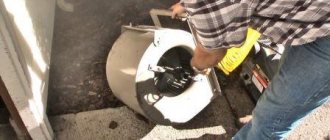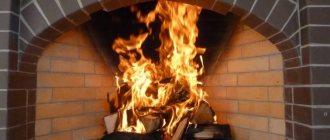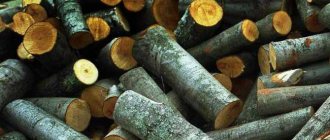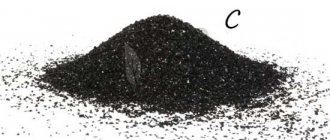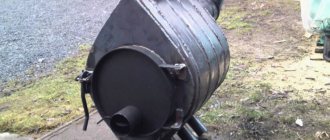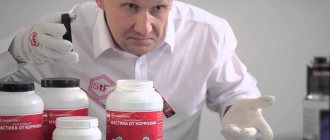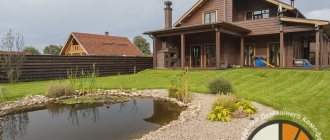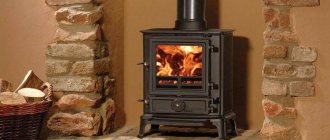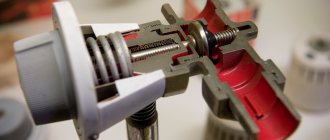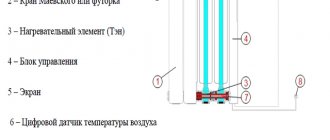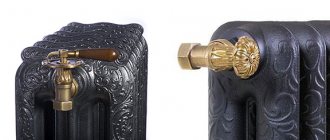Firewood is still used as fuel for stoves and fireplaces, and for cooking over open fires. Any user is interested in ensuring that the fuel he purchases ensures the maximum burning temperature of the wood. The ability to direct the maximum amount of heat energy obtained during the combustion of wood to heat the building, while minimizing possible losses, is the ultimate goal of every owner of an autonomous heating system. The heat output of logs used as fuel directly depends on factors such as:
- wood species;
- the volume of air mixture entering the firebox and its temperature;
- the actual moisture content of the firewood at the time of placing it in the firebox;
- calorie content (this term refers to the amount of heat energy obtained during the combustion of a unit of fuel).
Their combination has a direct impact on combustion efficiency. Dry wood burns longer and better than wet wood. The lack of oxygen supplied to the fireplace of firewood in the stove puts it in smoldering mode, which significantly reduces the amount of heat given off. Knowing this, you can purchase in advance what you need.
Temperature threshold for combustion of wood of various species
Depending on the structure and density of wood, as well as the amount and characteristics of resins, the combustion temperature of firewood, its calorific value, and the properties of the flame depend.
If the wood is porous, it will burn very brightly and intensely, but it will not produce high combustion temperatures - the maximum value is 500 ℃. But denser wood, such as hornbeam, ash or beech, burns at a temperature of about 1000 ℃. The combustion temperature of birch (about 800 ℃), as well as oak and larch (900 ℃) is slightly lower. If we are talking about species such as spruce and pine, then they light up at approximately 620-630 ℃.
Larch
The tree is second only to oak in terms of its thermal characteristics. It’s easier to chop it, and it’s easier to light it, too. Refers to coniferous, resinous species. It does not grow in all forests, but in some places it is found quite often, and in some places it forms larch taiga.
- Fire power: 0.81de.
- Calorific value: 3062 kWh/m³.
- Combustion temperature: 865 °C.
- Burning time: long.
- Flame: smooth, has a noticeable blue tint, sparkles, and can periodically “shoot.” Smokes.
- Coals: have a long smoldering time and good heat.
- Difficulty of lighting: above average. It is somewhat easier to light larch than oak, but you still have to build a small fire before throwing the log into it.
Use of wood based on its heat capacity
When choosing a type of firewood, it is worth considering the ratio of cost and heat capacity of a particular wood. As practice shows, the best option can be considered birch firewood, which has the best balance of these indicators. If you purchase more expensive firewood, the costs will be less effective.
To heat a house with a solid fuel boiler, it is not recommended to use types of wood such as spruce, pine or fir. The fact is that in this case, the combustion temperature of the wood in the boiler will not be high enough, and a lot of soot will accumulate on the chimneys.
Firewood made from alder, aspen, linden and poplar also has low thermal efficiency due to its porous structure. In addition, sometimes during the burning process alder and some other types of firewood shoot out coals. In the case of an open furnace, such micro-explosions can lead to fires.
It is worth noting that no matter what the wood is, if it is damp, it burns worse than dry wood and does not burn completely, leaving a lot of ash.
How to simplify the choice of chimney
What is a chimney for fireplaces? This is a set of pipes, one end of which is connected to a heating device, and the other is brought outside. Its installation is a rather complex and labor-intensive process that requires certain knowledge and professionalism. Chimneys can be made of brick, stainless steel, ceramics. Each of these types has its own advantages, disadvantages, as well as installation features. Of course, in order to make the right choice, it is better to seek advice from professionals. However, in order to have some idea about the design of chimneys, we provide below a brief description of the most common types.
Heat transfer when burning wood in a stove
There is a direct relationship between the combustion temperature of wood in a stove and heat transfer - the hotter the flame, the more heat it releases into the room. The amount of thermal energy generated is influenced by various characteristics of the tree. Calculated values can be found in reference literature.
It is worth noting that all standard indicators were calculated under ideal conditions:
- the wood is well dried;
- the furnace firebox is closed;
- oxygen is supplied in clearly dosed portions to support the combustion process.
Naturally, it is impossible to create such conditions in a home oven, so less heat will be released than calculations show. Therefore, the standards will be useful only for determining the general dynamics and comparing characteristics.
Elm
Elm is often found in broad-leaved and mixed forests and can form quite large clusters. It is hard, does not chip easily, but in terms of its heat characteristics it is approximately the same as birch. Just like it, it can burn in its raw form.
- Fire power: 0.77de.
- Calorific value: 2912 kWh/m³.
- Combustion temperature: 864 °C.
- Burning time: long.
- Flame: even, smokes moderately.
- Coals: very reminiscent of birch coals - they smolder for a long time and fry well.
- Lighting difficulty: medium.
What is the combustion process
An isothermal reaction in which a certain amount of thermal energy is released is called combustion. This reaction goes through several successive stages.
In the first stage, the wood is heated by an external fire source to the ignition point. As it heats up to 120-150 ℃, the wood turns into coal, which is capable of self-ignition. Once the temperature reaches 250-350 ℃, flammable gases begin to be released - this process is called pyrolysis. At the same time, smoldering of the top layer of wood occurs, which is accompanied by white or brown smoke - these are mixed pyrolysis gases with water vapor.
At the second stage, as a result of heating, the pyrolysis gases ignite with a light yellow flame. It gradually spreads over the entire area of the wood, continuing to heat the wood.
The next stage is characterized by ignition of the wood. As a rule, for this it should warm up to 450-620 ℃. For wood to ignite, you need an external heat source that is intense enough to rapidly heat the wood and speed up the reaction.
In addition, the rate of firewood ignition is influenced by factors such as:
- craving;
- wood moisture;
- cross-section and shape of firewood, as well as their quantity in one stack;
- wood structure - loose firewood ignites faster than dense wood;
- placement of the tree relative to the air flow - horizontally or vertically.
Let's clarify some points. Since wet wood, when burning, first evaporates excess liquid, it ignites and burns much worse than dry wood. Shape also matters—ribbed and jagged logs ignite more easily and quickly than smooth, round ones.
The draft in the chimney must be sufficient to ensure the flow of oxygen and dissipate thermal energy inside the firebox to all objects located in it, but not to blow out the fire.
The fourth stage of the thermochemical reaction is a stable combustion process, which, after the outbreak of pyrolysis gases, covers all the fuel in the furnace. Combustion goes through two phases - smoldering and burning with flame.
During the smoldering process, the coal formed as a result of pyrolysis burns, while gases are released rather slowly and cannot ignite due to their low concentration. The condensation of gases as they cool produces white smoke. As wood smolders, fresh oxygen gradually penetrates, causing the reaction to further spread to the rest of the fuel. The flame occurs as a result of the combustion of pyrolysis gases, which move vertically towards the outlet.
As long as the required temperature is maintained inside the furnace, oxygen is supplied and there is unburnt fuel, the combustion process continues.
If such conditions are not maintained, then the thermochemical reaction enters the final stage - decay.
Rowan
It is often found in large quantities in forests, mainly in the form of low undergrowth, however, on the edges and clearings it can grow to significant sizes. It is often found along the banks of rivers, especially taiga ones.
Rowan wood is quite dense, comparable in weight to bird cherry. Nothing is known about the exact calorific characteristics of rowan wood. In our practice, we have repeatedly come across dry mountain ash, which burned approximately like alder, but it did not produce any special coals.
How to determine the combustion temperature in a wood-burning stove
Measuring the combustion temperature of wood in a fireplace can only be done with a pyrometer - no other measuring instruments are suitable for this.
If you do not have such a device, you can visually determine approximate indicators based on the color of the flame. Thus, a low temperature flame has a dark red color. A yellow light indicates that the temperature obtained by increasing the draft is too high, but in this case more heat is immediately evaporated through the chimney. For a stove or fireplace, the most suitable combustion temperature will be one at which the color of the flame will be yellow, such as, for example, dry birch firewood.
Modern stoves and solid fuel boilers, as well as closed fireplaces, are equipped with an air supply control system to adjust heat transfer and combustion intensity.
Video installation of a sandwich chimney with your own hands
A feature of modern sauna stoves is their heating temperature, which can reach 400 degrees. An important indicator of the efficiency of the furnace is instant heating of the body and maximum heat transfer.
The entire heating process is accompanied by the release of infrared radiation, which is distributed on surfaces adjacent to the furnace. Under the influence of high temperatures, the wooden structure of the bathhouse can char or ignite.
This is why it is so important to ensure that wooden surfaces are reliably insulated from the heat of the stove. A protective screen and lining made of fire-resistant materials are suitable for this.
Heat output of wood
In addition to the value of calorific value, that is, the amount of thermal energy released during fuel combustion, there is also the concept of heat output. This is the maximum temperature in a wood-burning stove that the flame can reach when the wood is burning intensely. This indicator also completely depends on the characteristics of the wood.
In particular, if the wood has a loose and porous structure, it burns at fairly low temperatures, producing a light, high flame, and produces fairly little heat. But dense wood, although it flares up much worse, even with a weak and low flame gives a high temperature and a large amount of thermal energy.
Cedar
In mid-latitudes it is rather rare, but in more northern regions it grows everywhere. It has soft wood and cracks well. Cedar wood is good fuel for a fire.
- Fire power: 0.70de.
- Calorific value: 2645 kWh/m³.
- Combustion temperature: ~650 °C.
- Burning time: average.
- Flame: even, may spark. Smokes.
- Coals: quite hot, medium smoldering time.
- Lighting difficulty: easy.
Humidity and combustion intensity
If the wood was recently cut down, it contains from 45 to 65% moisture, depending on the time of year and the species. Such damp wood will have a low combustion temperature in the fireplace, since a large amount of energy will be spent on evaporation of water. Consequently, heat transfer from damp wood will be quite low.
There are several ways to achieve optimal temperature in the fireplace and release enough heat energy to warm up:
- Burn twice as much fuel at a time to heat your home or cook food. This approach is fraught with significant material costs and increased accumulation of soot and condensate on the walls of the chimney and in the passages.
- Raw logs are sawn, split into small logs and placed under a shed to dry. As a rule, in 1-1.5 years, firewood loses up to 20% of moisture.
- Firewood can be purchased already well dried. Although they are somewhat more expensive, their heat transfer is much greater.
It is worth noting that the wood of raw felled poplar and some other species is completely unsuitable for use as fuel. It is loose, contains a lot of water, so when burning it produces very little heat.
At the same time, raw birch firewood has a fairly high calorific value. In addition, raw logs made from hornbeam, ash and other dense wood species are suitable for use.
Weeds
Now is the time to consider alternative types of natural fuel that can be used to fuel a campfire.
Sometimes it happens that there is no dead wood near the camp, but conscience does not allow green trees to be cut (foresters do not allow them), or there is a decent distance to them. Then you have to get out with the help of herbaceous plants. As a rule, if the area is more or less wild and open, such large species of grass as:
- Sagebrush;
- Burdock;
- Thistles, thistles and others like them;
- Blooming Sally;
- Large umbelliferae: hemlock, kupir, angelica, hogweed (including the notorious giant one);
- Cane;
- Rogoz;
- Straw;
- Sunflower stems;
- Fire power: 0.1de.
- Calorific value: 378 kWh/m³.
- Combustion temperature: 800-900 °C.
- Burning time: very short.
- Flame: even, with a characteristic crackling sound. It smokes, the less dry the material, the stronger it is.
- Coals: does not actually form.
- Difficulty of lighting: extremely low, dry weeds are excellent kindling.
If the area is marshy or borders water, then the above list is supplemented by the following plants:
In rural areas, the following options are possible:
The best thing, of course, is thick, non-hollow stems (wormwood, burdock, sunflower). All this nonsense usually dries out in the fall, stands all winter, spring and the first third of summer, then - as the green herbs grow, most of last year's dry stems rot and fall off. However, you can collect a certain amount of such “wood” for a fire at any time of the year.
Dry weeds burn quickly and hotly; they actually do not form coals, because their density is very low. For a full-fledged night fire you will need ten cubic meters and a specially trained farmhand who will constantly throw this thing into the fire. It is also possible to use ingenuity: twist the grass into dense sheaves with twine. It will burn longer.
But in order to light a mini-bonfire, for example, for boiling water, weeds are quite suitable. The only thing you need is a few stones. So that you can lay out a small fireplace and not radiate heat into space in vain, thereby increasing the efficiency of the fire.
Next are the parameters of weeds as fire fuel (during the calculations, straw indicators were used as the initial parameters).
How does draft in a stove affect combustion?
If an insufficient amount of oxygen enters the furnace firebox, the intensity and temperature of wood combustion decreases, and at the same time its heat transfer decreases. Some people prefer to cover the ash in the stove to extend the burning time of one bookmark, but as a result, the fuel burns with lower efficiency.
If wood is burned in an open fireplace, then oxygen freely enters the firebox. In this case, the draft depends mainly on the characteristics of the chimney.
Under ideal conditions, the formula for a thermochemical reaction looks something like this:
C+2H2+2O2=CO2+2H2O+Q (thermal energy).
This means that when oxygen is available, hydrogen and carbon are burned, resulting in thermal energy, water vapor and carbon dioxide.
For the maximum combustion temperature of dry fuel, about 130% of the oxygen required for combustion must enter the furnace. When the inlet dampers are closed, an excess of carbon monoxide is produced due to a lack of oxygen. Such unburnt carbon evaporates into the chimney, however, the combustion temperature inside the firebox drops and the heat transfer of the fuel is reduced.
Modern solid fuel boilers are often equipped with special heat accumulators. These devices accumulate an excessive amount of thermal energy released during fuel combustion under conditions of good traction and high efficiency. This way you can save fuel.
In the case of wood-burning stoves, there are not many opportunities to save wood, since they immediately release heat into the air. The stove itself is capable of retaining only a small amount of heat, but an iron stove is not capable of this at all - excess heat from it immediately goes into the chimney.
Thus, by increasing the draft in the furnace, it is possible to achieve an increase in the intensity of fuel combustion and its heat transfer. However, in this case, heat loss increases significantly. If you ensure slow combustion of wood in the stove, then its heat transfer will be less, and the amount of carbon monoxide will be greater.
Please note that the efficiency of the heat generator directly affects the efficiency of wood burning. Thus, a solid fuel boiler boasts 80% efficiency, and a stove – only 40%, and its design and material matter.
Functions and features of operation of a chimney in a bathhouse
The main purpose of a chimney in a steam room is high-quality and controlled removal of combustion products in order to completely eliminate the accumulation of harmful carbon dioxide and the formation of burning on surfaces. The resulting draft (with air suction into the combustion chamber) maintains a stable operation of the heat generator. By manipulating the flows, the user regulates the heating value of the furnace and fuel consumption. You can heat such a sauna stove for as long as you like, and you can steam all this time.
Features of heat distribution with different methods of connecting the heater to the chimney
The stove in the bathhouse is heated inconsistently. Accordingly, the smoke channel cools down completely between sessions, so the chimney parts experience the strongest repeated thermodynamic loads. The second important factor is operating temperature. Unlike boilers and furnaces used for heating, gases heated to 700 degrees or more are removed here. Direct-flow stoves are often used in the bathhouse; due to the lack of heating shields or water jackets that remove some of the heat, the smoke turns out to be so hot. Therefore, the problem of chimney burnout (the danger of gas contamination and fire) always remains relevant. Chimneys for bathhouse stoves are made from high-quality materials. If these are factory products, they must be approved by the manufacturer for such difficult operating conditions.
What kind of wood is better to burn?
The heat output of the heating device and the burning time greatly depend on the type of wood.
At the molecular level, wood consists of many empty cells with walls made of woody matter. The density of this woody substance (walls) is the same for all types of wood, but the size of the cells is different.
The smaller the size of the cells, the higher the density of the wood and each square centimeter contains a lot of flammable wood matter. And vice versa: the larger the size of the cells, the lower the density of the tree. It contains a lot of air and little flammable wood matter.
Imagine that a circle is 1 square centimeter of wood. In the first case, the cells are small and there are many walls between them. In the second case, the number of cells and walls is smaller, and there are more voids filled with air. The density of such wood is low.
What conclusions can be drawn:
- Less dense wood burns quickly
. When wood burns, air is released, which fuels the combustion. The more air, the firewood burns faster and less evenly. - Dense firewood produces more heat
because it contains more combustible wood matter per unit volume. - Dense firewood leaves more coals
, which take a long time to smolder. Soft woods hold their shape less well, crumble into small coals and go out quickly.
All wood is divided into three density categories: low, medium, high.
Remove soot promptly
Soot needs to be removed not only when the chimney is clogged, but regularly. Soot not only impairs chimney draft, but also serves as thermal insulation. It covers the internal walls of the heating device and the heat exchanger, which reduces their heat transfer. If soot is removed in a timely manner, the volume of wood burned can be reduced without loss of heating power.
Obvious, but worth remembering: the firewood must be dry. Wet wood does not ignite well, goes out quickly and emits 2-2.5 times less heat than dry wood.
Horse fire: types, characteristics, causes and rules of extinguishing
A crown fire is a forest fire that engulfs the forest canopy (tree tops), which is especially dangerous in coniferous trees.
Forest fires are quite common in dry, windy and warm weather. It can not only kill many trees, but also leave people homeless.
They can be grassroots, soil (peat) and upland. A strong crown fire occurs quite rarely, and, as a rule, in inaccessible mountainous areas. Because of this, it is not always possible to get to it quickly and eliminate it at the initial stage.
The characteristics of the behavior and spread of such a fire are still being studied.
There are very few ways to fight such fires, but they can cause extremely serious damage. Let us consider in more detail why crown fires are dangerous, why they occur, and what technologies are currently used to combat them.
This type of forest fire disaster is a continuation of ground fires. They seem to rise upward, and a strong wind throws sparks across the treetops. There is a high risk of such fires in thickets of young coniferous trees, as well as oak trees with the form of a bush. Last year's dry grass is especially dangerous in the spring with no precipitation.
In these forest zones, crown fires almost always occur. After it, coniferous areas die completely. They are characterized by the fact that the fire covers the ground cover, and as a result, the entire strip of the tree stand is exposed to burning. The main part is a ground fire, so it is extremely important to prevent it from becoming a rising fire.
The cause of crown fires in this forest belt is strong wind, and the steepness of mountain slopes can also contribute to its development. In such a situation, it is easier for the fire to climb the mountain. Such fires should be expected to occur in the summer season. The risk especially increases during dry periods combined with strong winds.
In appearance, he can be fluent and stable. In the first case, the movement of fire along the edge of trees can occur much faster than the movement of a ground fire. In the presence of wind, as a rule, only cursory overhead fires occur.
The stable version moves simultaneously with the edge of the fire below. There is no independent spread through the crowns of nearby trees. They are also sometimes called general fires.
The speed of crown fires also depends on the species. For a stable one, it can vary from 300 to 1500 m/h. In the fluent version, the speed is much higher, from 4000 – 5000 m/h.
Such fires are associated with the release of large amounts of heat, which has an extremely negative impact on the environment. Hot air together with combustion products can cause the formation of upward flows with columns up to 100 m in diameter. They move simultaneously with the main fire front. In the center of the column, the flame can reach a height of 120 m. Moreover, the constant flow of clean air contributes to the intensification of the crown fire. This phenomenon is called a firestorm.
Raised fires are also divided according to the speed of flame spread: weak up to three meters per second, medium up to one hundred meters per second, and strong over one hundred meters per second.
Methods for eliminating crown fires
Such a fire can be extinguished by creating gaps about 10 fathoms wide, using roads, existing clearings and large clearings. It is recommended not to start cutting very close to the fire, so that, due to the heat and smoke, you will not be forced to abandon the felling before the desired goal is achieved.
Another tactic against crown fires is annealing, or launching a controlled backfire. This method of fighting is considered the most effective. To begin with, annealing is started in the direction in which the spread of the fire will become more dangerous and difficult. For example, they try to prevent fire from advancing to densely populated mountain slopes. There it will be practically useless to fight him.
Birch bark torches are used to create annealing. The fire is launched along the very edge of the support strip, opposite the main front of the mounted fire. There are no gaps.
When extinguishing a crown forest fire, you should know that at night the speed always decreases, and the spread along the treetops practically disappears. The most effective fight will be in the late evening, at night or in the pre-dawn hours. In order not to worsen the situation and not cause the formation of new fires, such an operation should only be carried out by competent specialists.
Close the valve in a timely manner
The stronger the draft, the faster the wood burns. But if there is not enough air, they burn poorly and form a lot of soot. Balance is important so that the minimum amount of air necessary for combustion reaches the firewood.
- Before ignition, open the heater damper to the maximum to ensure good draft for igniting the wood.
- When the wood starts to burn, begin to gradually close the valve. If the firewood starts to go out, open the valve slightly and increase the draft. Over time, you will find the optimal valve position.
The drier and denser the wood, the less air is required to burn it.
Preheat the firebox
When wood starts to burn in a cold firebox, then:
- part of the heat is spent on heating the firebox, and not heating the room (as in the previous point).
- It is more difficult for them to flare up, since warm air overcomes the resistance of cold air in the chimney.
Basic firewood is best lit in a preheated firebox so that it does not waste extra energy heating the firebox and chimney. You can use the heat from the previous stack of firewood or pre-burn the prepared torches and paper in the firebox.
Dung
Dried (to the point of complete dehydration) cattle manure can also help a tourist out of woodlessness. Cow patties burn very well and take a long time, and they produce quite a bit of heat.
Unfortunately, it was not possible to find the exact parameters of dung as a fuel either in the literature or on the Internet, despite the fact that in many rural areas and agricultural countries it is a traditional method of heating. But they say that in terms of its characteristics, dung roughly corresponds to peat.
Alternatives to a campfire
Of course, it is impossible to replace a fire with one thing that would fully perform its functions without requiring fuel. However, this does not mean at all that it is impossible to do without a fire: a combination of different equipment, techniques and materials can completely replace a fire, in some cases even surpassing it in efficiency.
For example, burners can be used for cooking, which is used by tourists going on mountain hikes. Burners, of course, have their drawbacks, but compared to a fire, they do not smoke, are compact and safer in terms of fire.
In the region of the tropics and the equator, food can be cooked on sun-heated stones or sand, or you can simply take food that does not require heat treatment on a hike.
For heating in the absence of a fire, you can use special heating pads in combination with warm clothes and a sleeping bag, and in the most extreme cases, in the absence of any equipment, a pile of rotting grass: when rotting, heat is released, and the temperature of such a pile can even be higher than the temperature of the human body.
For drying wet things, ropes stretched between trees, as well as the branches of the trees and bushes themselves, on which it is convenient to weigh everything that needs to be dried, have proven themselves to be effective. In warm, dry weather, you can dry things on the go by hooking them onto your backpack. As a last resort, clothes can be dried directly on the body, but this is only permissible if the person is not in danger of hypothermia.
Lanterns are best for lighting. Compared to a fire, they are easier to carry, you can adjust the brightness, turn them on and off when needed, and use them in a tent. Flashlights are safer and easier to use.
But if you don’t have to dive underground, travel to a cave, or travel at night through a wooded area, in the absence of a fire and a flashlight, you can get by with natural lighting created by the stars and the Moon.
Special clothing and repellents will save you from blood-sucking insects. From my experience, I can say that these means of protection are significantly more effective than smoke from a fire; in addition, they are less harmful to the human body and act wherever a person goes.
If you treat your skin with a good repellent as shown in the photo, mosquitoes will not bite for 2-3 hours:
As you can see, despite the versatility of a fire as a means of survival, in some situations you can still do without it, without being particularly strained by the inconveniences that arise.
For example, on a summer weekend hike you can completely do without fires, saving time on collecting firewood, preparing a fire pit, lighting a fire, cooking food and extinguishing firebrands, as well as nerves and financial resources from a possible visit from foresters. At the same time, in an emergency situation that occurs in a winter forest in the absence of a sleeping bag, it is unlikely that it will be possible to do without a fire: heating pads sold in specialized stores in this case will be ineffective, even if they end up in the victim’s pocket, and only a well-organized fire in this case will give hope for salvation.
Fire temperature of various flame sources
The temperature of the fire makes you see ordinary things in a new light - a match flashing white, the blue glow of a gas stove burner in the kitchen, orange-red tongues above a flaming tree. A person does not pay attention to the fire until the ends of his fingers are burned. Or it won't burn the potatoes in the frying pan. Or it won’t burn through the soles of sneakers drying over a fire.
When the first pain, fear and disappointment pass, the time for philosophical reflection comes. About nature, color palette, fire temperature.
Folk tales
Superstitions and beliefs circulate among the people. For example, it is believed that it is better to prepare firewood for a bath during the waning moon. Moreover, the thinner the sickle, the stronger the logs are endowed with healing powers. Once upon a time, the Slavs believed that people who left the world turned into maples in their lives. The appearance of its leaves is akin to open palms, and its branches represent hands raised to the heavens. For this reason, they never fired maple stoves.
In the old days, residents of the Tambov province heated their stoves exclusively with apple trees to keep the house warm throughout the winter, including especially frosty days. Whether to believe all this or not is everyone’s business, but what happened was what happened. What do you, dear readers, think: what kind of firewood is better for a stove, bathhouse or fireplace?
Studying fire in our kitchen
Kitchen stoves operate on 2 types of fuel:
- Main network gas methane.
- Propane-butane liquefied mixture from cylinders and gas holders.
The chemical composition of the fuel determines the fire temperature of the stove. Methane, when burned, forms a fire with a power of 900 degrees at the top point.
Combustion of the liquefied mixture produces heat up to 1950°.
A sensitive observer will notice the uneven coloring of the burner reeds of a kitchen stove. From inside the fire torch, fragmentation occurs into three zones:
- A dark area located near the burner: there is no combustion due to the lack of oxygen, and the temperature of the zone is 350°.
- a light area lying in the very center of the torch: the burning gas heats up to 700°, but the fuel does not burn completely due to the minus oxidizer.
- Translucent top section: can reach a temperature of 900°, and the gas combustion is real.
Figures for flame temperature zones are shown for methane.
A couple of phrases about calorific value
In terms of its chemical composition, wood is a rather complex material. It contains the main components - lignin and cellulose. But besides them, the tree contains:
- resins;
- proteins;
- tannins and other ingredients.
When logs burn in a stove (or simply when trees burn in a forest), these components interact with the air at a chemical level. The calorific value of wood (as well as any fuel), or thermal conductivity, is the amount of thermal energy that a unit of weight of the fuel material (in our case, 1 kg of wood) produces during combustion. Kilocalories are used to measure quantities.
The chemical composition among most tree varieties has minimal variations, which causes differences in the number of calories emitted. That is, the heat of combustion of some types of firewood can be as follows:
- for deciduous species the figure is 4460 kcal/kg;
- for coniferous species - 4560 kcal/kg;
- for mixed breeds – 4510 kcal/kg.
As you can see, the differences are minimal. At the same time, it is easy to understand that it is better to use coniferous wood for the stove due to its greater thermal conductivity. Only firewood is supplied to the market depending on volume, not weight. That is, the main criterion for choosing firewood is cubic meters. Density plays an important role here, because the higher it is, the heavier the wood.
For example, let’s take 1 cubic meter of birch logs as a starting point. Then the ratio of the volume of different rocks will look like this:
- oak logs - 0.75 cubic meters. m;
- alder logs - 1.1 cubic meters. m;
- pine logs - 1.2 cubic meters. m;
- spruce logs - 1.3 cubic meters. m;
- aspen logs - 1.5 cubic meters. m.
That is, 1 cubic meter of birch and 0.75 cubic meters. m of oak logs, 1.1 cubic meters. m of alder wood (and so on) will produce the same amount of heat. Knowing this, now, depending on how much firewood costs, you can get profitable savings for yourself.
Prepare firewood in advance
Bring the wood into a warm room 2-3 days before lighting to increase its initial temperature.
The warmer the wood is initially, the:
- They spend less heat on their own heating and more on heating the room. You use heat more beneficially.
- Firewood reaches its optimal combustion mode faster, which further increases its calorific value and reduces the amount of soot emitted. This happens because the resin, creosote, tar, essential oils and other substances contained in wood do not burn at low temperatures and are deposited on the walls in the form of soot. And under optimal conditions, the combustion temperature is sufficient for them to burn entirely and release additional heat.
The difference between the combustion of “warm” and “cold” firewood is immediately noticeable: cold firewood produces a lot of smoke, which characterizes incomplete combustion. And warm, dry wood burns with virtually no smoke.
Fire designer
When hearing the word “bonfire,” no less vividly nostalgic memories flash up: the smoke of a fire, creating a trusting atmosphere; red and yellow lights flying towards the ultramarine sky; the iridescence of the tongues from blue to ruby red; crimson cooling coals in which “pioneer” potatoes are baked.
The changing color of the flaming wood communicates the temperature changes of the fire in the fire. Wood smoldering (darkening) begins at 150°. Combustion (smoke) occurs in the range of 250-300°. With the same supply of oxygen, tree species burn at different temperatures. Based on this, the degree of fire is also different. Birch burns at 800 degrees, alder at 522°, and ash and beech at 1040°.
Enthusiasts of scientific experiments measure the temperature of the fire in a fire with a device called a pyrometer. Three types of pyrometers are made: optical, radiation, spectral. These are non-contact devices that allow you to evaluate the power of heat radiation.
conclusions
From all of the above, the following conclusions can be drawn:
Literature [edit | edit code]
Tideman B. G., Sciborsky D. B.
Chemistry of combustion. - L., 1935.
The first chemists believed that fire was caused by the release of the substance “phlogiston” from bodies, which contains all explosive and flammable materials. But in the 18th century it was proven that the cause of combustion was a less mysterious element - oxygen. According to this model of the phenomenon, the flame indicates the place of interaction of the oxidizer with the combustible material, and its color indicates the temperature of the fire.
Read also: Steel grade for bolts and nuts
Classification [edit | edit code ]
Flames are classified according to:
- state of aggregation of flammable substances: flame of gaseous, liquid, solid and aerodispersed reagents;
- radiation: luminous, colored, colorless;
- state of the fuel-oxidizer environment: diffusion, pre-mixed media (see below);
- the nature of the movement of the reaction medium: laminar, turbulent, pulsating;
- temperature: cold, low temperature, high temperature;
- propagation speeds: slow, fast;
- height: short, long;
- visual perception: smoky, transparent, colored.
Inside a laminar diffusion flame
3 zones (shells) can be distinguished:
- dark zone (300-350 °C), where combustion does not occur due to a lack of oxidizer;
- luminous zone where thermal decomposition of fuel and its partial combustion occurs (500–800 °C);
- a barely luminous zone, which is characterized by the final combustion of fuel decomposition products and a maximum temperature (900–1500 °C).
The flame temperature depends on the nature of the combustible substance and the intensity of the oxidizer supply.
Flame propagation through pre-mixed medium
(unperturbed), occurs from each point of the flame front normal to the flame surface: the value of such
normal flame propagation velocity
(NFSV) is the main characteristic of the flammable medium. It represents the minimum possible flame speed. NSRP values differ for different combustible mixtures - from 0.03 to 15 m/s.
The spread of flame through real-life gas-air mixtures is always complicated by external disturbing influences caused by gravity, convective flows, friction, and so on. Therefore, the actual flame propagation speeds always differ from normal ones. Depending on the nature of combustion, the flame propagation speeds have the following ranges: for deflagration combustion - up to 100 m/s; during explosive combustion - from 300 to 1000 m/s; during detonation combustion - over 1000 m/s.
Oxidizing flame [edit | edit code]
Located in the upper, hottest part of the flame, where combustible substances are almost completely converted into combustion products. In this area of the flame there is an excess of oxygen and a lack of fuel, so substances placed in this zone are intensively oxidized
.
Restorative Flame [edit | edit code]
This is the part of the flame closest to the center or just below the center of the flame. In this area of the flame there is a lot of fuel and little oxygen for combustion, so if you introduce a substance containing oxygen into this part of the flame, the oxygen is taken away from the substance.
This can be illustrated using the example of the reduction reaction of barium sulfate BaSO4. Using a platinum loop, BaSO4 is taken and heated in the reducing part of the alcohol burner flame. In this case, barium sulfate is reduced and barium sulfide BaS is formed. That's why the flame is called restorative
.
The color of the flame depends on several factors. The most important are: temperature, the presence of microparticles and ions in the flame, which determine the emission spectrum.
Flame in zero gravity [edit | edit code]
In conditions where the acceleration of free fall is compensated by centrifugal force, for example, when flying in the orbit of the earth, the combustion of a substance looks somewhat different. Since the acceleration of gravity is compensated, the Archimedes force is practically absent. Thus, under conditions of weightlessness, combustion of substances occurs at the very surface of the substance (the flame is not drawn out), and combustion is more complete. Combustion products gradually spread evenly in the environment. This is very dangerous for ventilation systems. Powders also pose a serious danger, so powdered materials are not used anywhere in space, except for special experiments with powders.
In a stream of air, the flame stretches out and takes on its usual appearance. The flame of gas burners, due to gas pressure in conditions of weightlessness, also does not differ in appearance from combustion in earthly conditions.
Safety
- Before starting the experiment, put on protective gloves and goggles.
- Conduct the experiment on a tray.
- When conducting the experiment, keep a container of water nearby.
- Remove gloves before lighting the torch.
General safety rules
- Do not allow chemicals to come into contact with your eyes or mouth.
- Keep people away from the experiment site without protective glasses, as well as small children and animals.
- Keep the experimental kit out of the reach of children under 12 years of age.
- Wash or clean all equipment and fixtures after use.
- Ensure that all reagent containers are tightly closed and stored properly after use.
- Make sure all disposable containers are disposed of correctly.
- Use only the equipment and reagents provided in the kit or recommended by current instructions.
- If you have used a food container or glassware for experiments, throw it away immediately. They are no longer suitable for storing food.
First aid information
- If reagents come into contact with your eyes, rinse thoroughly with water, keeping the eye open if necessary. Contact your doctor immediately.
- If swallowed, rinse mouth with water and drink some clean water. Do not induce vomiting. Contact your doctor immediately.
- If reagents are inhaled, remove the victim to fresh air.
- In case of skin contact or burns, flush the affected area with plenty of water for 10 minutes or longer.
- If in doubt, consult a doctor immediately. Take the chemical reagent and its container with you.
- In case of injury, always seek medical attention.
